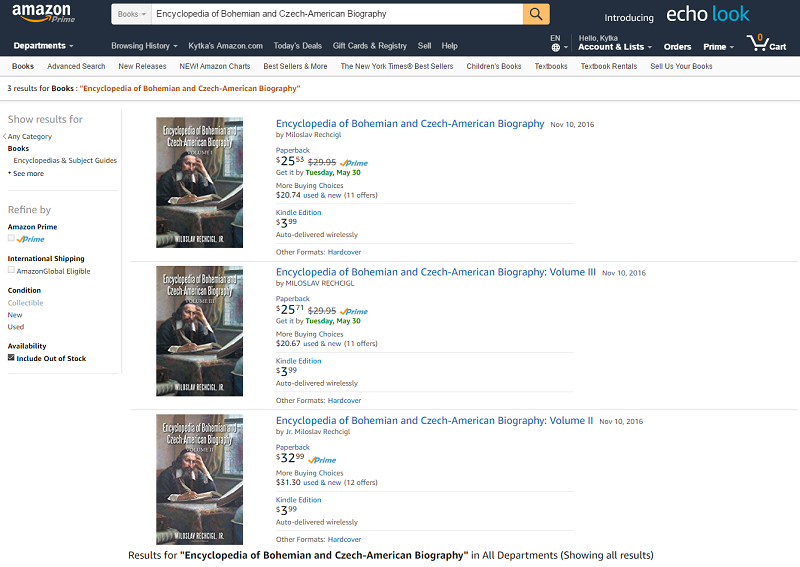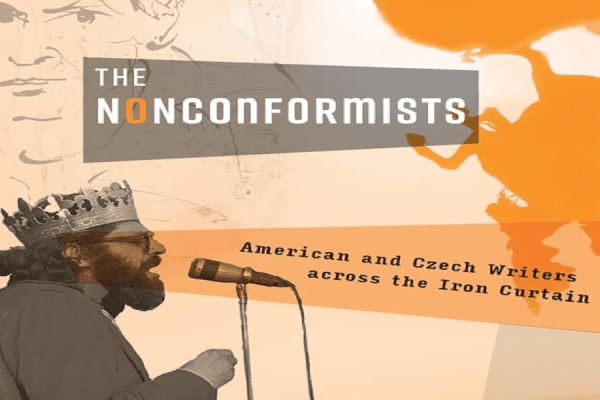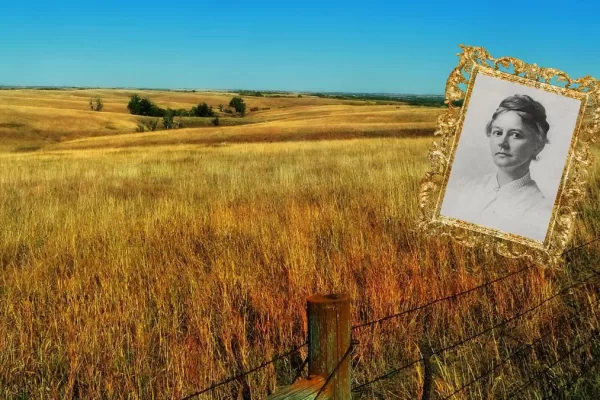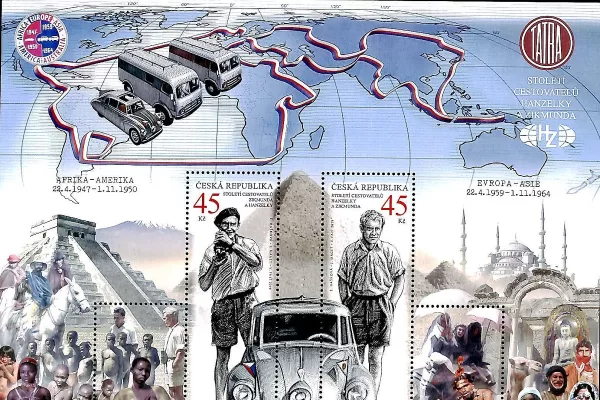Today we’re sharing a message from the Czech Ambassador who praises Mila Rechcigl’s Encyclopedia of Bohemian and Czech-American Biography. You’re surely familiar with some of Mila’s work by now because he has been kind enough to allow us to share some of it here at Tres Bohemes. The work we’re looking at today was published in 2016 by Author House, and you can immediately sense the praise from the foreword written by H.E. Petr Gandalovič, the Czech Ambassador to the United States at the time. He writes:
It is indeed my great pleasure and honor to endorse this latest endeavor of Míla Rechcígl, whom I have known for years, as a ‘Renaissance’ scholar and a good friend.
Míla Rechcígl, SVU Scholar-in-Residence and one of the founders and Past President of the Czechoslovak Society of Arts and Sciences (SVU) of many years, has written a monumental work, representing a culmination of his life achievement as a historian of Czech America. Although a biochemist and science administrator, by training and profession, his love has been really in immigration history and in the study of Czech Americans and their contributions to the growth and the development of the United States.
Encyclopedia of Bohemian and Czech-American Biographyy is an unique and unparalleled publication. Notwithstanding the fact, that the preparation of a comprehensive “Who’s Who” type of publication has been contemplated for more than a century, nobody was willing to undertake such an enormous effort. Frankly, except for a few minor memorial-type of ethnic publications on a local level, no comprehensive biographical reference has ever been assembled, not even at segmental level.
The enormity of this undertaking boggles the mind, considering that it covers a universe, starting a few decades after the discovery of the New World, through the escapades and significant contributions of Bohemian Jesuits and Moravian Brethren in the 17th and 18th centuries, and the mass migration of the Czechs after the Revolutionary Year of 1848, up to the early years of the 20th Century, and the influx of refugees from Nazism and Communism.
This publication is also a superb contribution to America, as well as to Czech, cultural history, considering that no real significant work in this area has been written since the time of Tomáš Čapek, who was considered ‘the historian of Czech America,’ whose classical books came out almost a century ago. I venture to say that Míla Rechcígl can be viewed as the second Tomáš Čapek, whom he may even have surpassed.
For the Czech Republic and for me, this work is of great significance and benefit. It reveals the profound and widespread Czech influence on the development of the US from the earliest beginnings to the present. Rechcigl’s work helps to preserve the memory of the Nation. In terms of national identity and the cooperation between the Czech and American Nations, his work is indispensable.
Petr Gandalovič
Ambassador of the Czech Republic
= = = = =
About the Books
Though they must appear in 3 separate volumes due to size, The Encyclopedia of Bohemian and Czech-American Biography should be viewed as one entity and is composed in a way that all three volumes are needed. Each volume has its own Table of Contents, but only Volume I contains the introductory information and only Volume III has the composite Name Index which covers all 3 volumes. Therefore, we recommend you purchase ALL THREE VOLUMES to have the complete work.
The Encyclopedia of Bohemian and Czech-American Biography is a set that comes in three separate parts;
Volume I (click here)
Volume II (click here)
Volume III (click here)
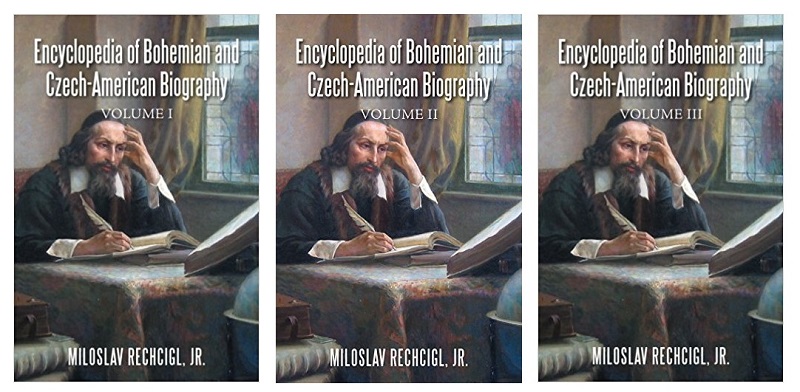
This encyclopedia covers a universe, starting a few decades after the discovery of the New World, through the escapades and significant contributions of Bohemian Jesuits and Moravian Brethren in the seventeenth and eighteenth centuries, and the mass migration of the Czechs after the revolutionary year of 1848 up to the early years of the twentieth century and the influx of refugees from Nazism and Communism.
This encyclopedia encompasses significant individuals from the earliest known entry of a Czech on American soil to date, including the contemporaries. Included are not only those individuals born in the Czech Lands, who immigrated to America, but also their descendants, irrespective of the generation.
For easier use, instead of alphabetical arrangement, the publication has been arranged into specific sections by various facets and areas of human endeavor, covering business, religion, government & politics, law, music, dramatic art, visual art, creative writing, publishing, media, education, activism & reform, the humanities, social sciences, biological sciences, physical sciences & mathematics, engineering, medicine, military, exploration, espionage, sports, modeling, and recreation.
The publication has an alphabetical index as well, which is included in Volume III.
Today we’re sharing the Preface of this extensive body of work.
= = = = =
PREFACE
Czech colonists and settlers began appearing in America soon after the discovery of the New World. There are actually records of one Johann Berger of Osoblaha (Hotzenplotz), Moravia, who in 1519 took part as a soldier in the expedition of Herman Cortés against the Aztecs. Hans Trumpel was the name of one of the miners from Jáchymov, Bohemia who left for America in 1528 via Antwerp and Seville, sailing off for San Domingo on the island of Haiti. In 1585, Joachim Gans of Prague, Bohemia, a metallurgist by trade, was a member of the first English colonization effort in America – at Roanoke, VA (present NC). The legendary Augustine Heřman (1621-1686), a native of Prague in the Kingdom of Bohemia, as he proudly declared in his Last Will and Testament, the maker of the first accurate map of Maryland and Virginia, is considered one of the first historically documented settlers from the Czech Lands in North America. His contemporary, Frederick Philipse (1626-1702), a descendant of a Bohemian aristocracy, was the wealthiest person in New Amsterdam (the present New York City).
Following these pioneers, a number of other Czechs arrived on the American shores, first individually, but later as families, who grew into tens of thousands during a number of waves of mass migration from the territory of the Kingdom of Bohemian and its Successor States. As a whole, these people played a significant role in the development of the Americas, be it the United States, Canada or the Latin America.
Of historical significance was the arrival, prodigious activities, escapades, poignant sufferings and unique contributions of the Jesuit missionaries in Latin America in the 17th and 18th centuries and of the Moravian Brethren in North America in the 18th century. The mass migration of Czechs from the Habsburg Empire in the second half of the 19th and early part of the 20th centuries was followed by the contemporary exodus of Czech exiles from Nazism and Communism.
Although abundant information exists about the reasons for the Czech migration to the New World, and general and regional histories have been written, documenting the life of the settlers and their families in hundreds of Czech communities, relatively little attention has been paid to specific individuals of Czech ancestry and their contributions to their new homeland. Time and time again, calls were made for preparation of a representative authoritative biographical compendium, but because of the enormity of the undertaking, the idea was not realized. The present Encyclopedia Czech American Biography intends to fill this void.
In contrast to the traditional Who’s Whos that are quite impersonal, terse, telegraphic in style, full of abbreviations, which make them hard to read, and, frankly unpalatable, if not boring, the present compiler/ author has chosen an encyclopedic style with a flowing narrative to make biographies more interesting and pleasure to read. This has not been a commercial venture but rather a serious scholarly endeavor. The selection of entries has been based strictly on the relative importance of the individuals, without any fiscal demands or obligations, which frequently is the case with the commercial Who’s Who- type of publications.
In terms of coverage, the Encyclopedia encompasses significant individuals from the earliest known entry of a Czech on American soil to date, including the contemporaries. Included are not only those individuals born in the Czech Lands, who immigrated to America, but also their descendants, irrespective of the generation. For easier use, instead of alphabetical arrangement, the publication has been arranged into specific sections by various facets and areas of human endeavor, covering business, religion, government & politics, law, music, dramatic art, visual art, creative writing, publishing, media, education, activism & reform, the humanities, social sciences, biological sciences, physical sciences & mathematics, engineering, medicine, military, exploration, espionage, sports, modeling, and recreation. The publication, however, has an alphabetical index as well.
This project has been approached strictly geographically, irrespective of the language and ethnicity. Actually before the 20th century, the official language in the Czech Lands was German, while Czech (Bohemian) was spoken only in remote villages. Moreover, the inhabitants were then generally known as Bohemians (Böhme in German). The term “Čech” (Tscheche in German) began to be used only toward the end of the 19th century. Following the Thirty Year War, in the early part of the 17th century, and particularly after the defeat of the King of Bohemia army at the Battle of the White Mountain, the country was completely Germanized and, even more so, during the reign of Maria Teresa.
The publication deals exclusively with the Czechs (‘Bohemians’), although some Slovaks may have been inadvertently included, because during the era of the Czechoslovak Republic, Slovak nationals frequently stated that they were natives of Czechoslovakia without specifying their ethnic origin. However, a number of Slovak natives have been included here intentionally, if they resided or were educated in the Czech Lands.
The Encyclopedia has been planned as a representative, comprehensive and authoritative reference tool, encompassing over 5,000 biographies, of which a good one fifth of the listed individuals has been contacted personally, to recheck their data and to ascertain their ethnic background.
Because of the plethora of the material, the biographical entries have had to be kept relatively brief, with emphasis on educational background and the contributions of the listed individuals, leaving out the inconsequential details of their life, unless the information contributed to the understanding of the persons’ accomplishments. The original diacritical marks were retained in the names of the immigrant settlers; in subsequent generations they were not employed, unless specifically used by some of the persons.
This prodigious and unparalleled encyclopedic vade mecum, reflecting enduring contributions of notable Americans with Czech roots, is not only an invaluable tool for all researchers and students of Czech-American history, but also a cart blanche for the Czech Republic, which considers Czech-Americans as their own and as a part of its magnificent cultural history.
About the Author
Míla Rechcigl, as he likes to be called, is a versatile person with many talents, a man of science and organization professionally, and Renaissance man by breadth of his knowledge and scholarly interests. Born in Czechoslovakia to a son of the youngest member of the Czechoslovak Parliament, he spent the War years under Nazi occupation and after the Communist’s coup d’état escaped to the West and immigrated to the US. We hope you’ll read his complete biographical profile here.
The Encyclopedia has been planned as a representative, comprehensive and authoritative reference tool, encompassing over 7,500 biographies. This prodigious and unparalleled encyclopedic vademecum, reflecting enduring contributions of notable Americans with Czech roots, is not only an invaluable tool for all researchers and students of Czech-American history, but also a cart blanche for the Czech Republic, which considers Czech-Americans as their own and as a part of its magnificent cultural history.
Make sure to get your copies on Amazon today…
If you have not already subscribed to get TresBohemes.com delivered to your inbox, please use the form below now so you never miss another post.
Remember, we rely solely on your donations to keep the project going.
Become a friend and get our lovely Czech postcard pack.

